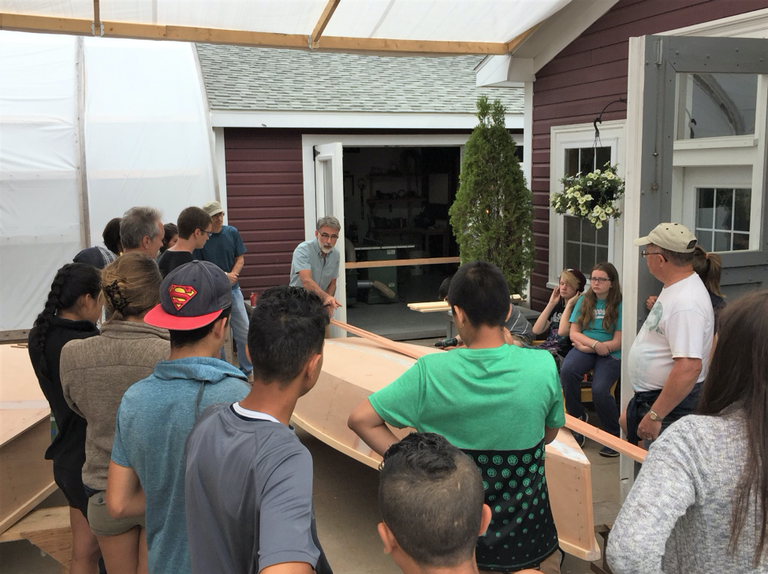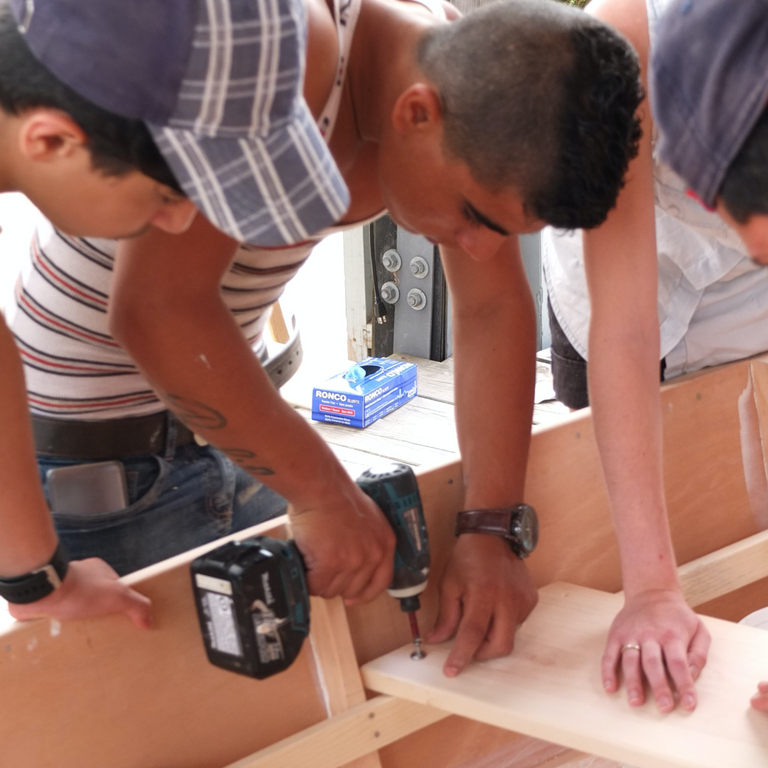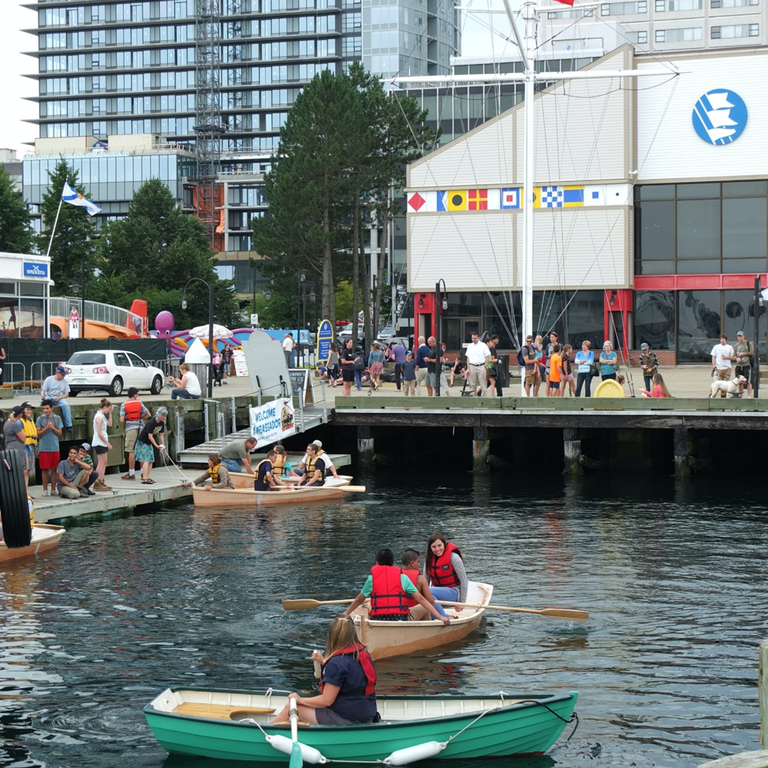
At the Maritime Museum of the Atlantic, They Build More Than Boats
Aleen Leigh Stanton for Culture Days
Aug 5, 2020
Another drill bit bites the dust, snapping in half with a ‘clunk’—and it’s not even 10am yet. Broken drill bits are a normal casualty of what the Maritime Museum of the Atlantic Master Boatbuilder, Eamonn Doorly, calls “hurricane boatbuilding.” It does feel as if you’re in the eye of a storm. Groups of youth are gathered together around piles of wooden boat kits milled by the Museum: everything needed to build a 12-foot rowboat. They have three days to turn this flat pile of pieces into a watertight vessel. The Museum calls its program “Building Boats, Changing Lives”.

After a brief pep talk and outline from Doorly, and with no time to waste, each group sets to work marking the centre frame, attaching the sides to the stem, and aligning the transom. Most of the pieces in the kit are purposely cut long, so participants have to learn to cut, plane, and sand them down to fit tightly. Museum volunteers teach the new boatbuilders to use tools commonly used in wooden boatbuilding: handsaws, jack and block planes, and even hammers and drills, when needed.
Building a boat is a process of thinking, knowing, and doing—of learning and creating, which are the two most important of all human activities. It is not a single big job; it is a thousand little jobs, some of them done over and over and over.

Day 1 is over before you know it, and everyone goes home a little sore, but satisfied to see their boat taking shape. By Day 2, with the exterior of the rowboat complete, the builders add the interior frames, seat risers, and seats. In between the major steps there is always more planing, sanding, and tweaking to do to prepare for the big launch on Day 3.
Situated on the boardwalk in the heart of the busy Halifax waterfront, the Maritime Museum of the Atlantic (MMA) was searching for a way to open up the doors of its boatshop and become a community anchor. They found it through the unexpected intersection of traditional craftsmanship and youth outreach.

Inspired by the Family Boatbuilding concept introduced in WoodenBoat Magazine in 1998, the MMA’s program is simple: gather a few ‘families’—whether bound by blood or simply friendship—give each group a kit of pieces for a 12-foot rowboat, and help them put the pieces together in three days. Family Boatbuilding spreads wooden boatbuilding to a wider audience and keep the craft alive and vital.1

The Alexandria Seaport Foundation, in particular, ran with this idea. They introduced an element of social action, training and employing at-risk youth as apprentices. In the process, they also raised the profile of the movement, publishing Bevin’s Skiff plans for other institutions to use for their own events.2 This is where the MMA found their direct inspiration, and they are not alone. Similar programs have sprung up throughout the Eastern Seaboard and along the West Coast, independently run by an eclectic collection of museums, historical societies, boatyards, and community non-profits.3
The MMA built its first two boats in 2014. The next year, three. Then, four. Now, it runs the program multiple times a year in partnership with Mount Saint Vincent University’s Child and Youth Studies program.4
Every time the MMA runs the program, the excitement on Day 3 feels fresh. By midday, the last quarter knee has been sanded, and each boat christened and ready to launch. Everyone gathers on the floating dock, poised to push their boats into Halifax harbour. They seem a long way from the Day 1 version of themselves. At first, they were reluctant to jump in with hammer in hand, afraid of making mistakes. They soon realized that, in itself, was a mistake. Here, mistakes are celebrated instead of frowned upon—they’re the best teachers.

The participants now know how to sand, plane, use a bevel gauge, build upside down, and drill straight. They can also translate angles, apply boatbuilding math, tell the difference between types of wood, and identify a transom or a seat riser. Above all, they’ve absorbed craftsmanship as a concept—what Richard Sennet called “the desire to do a job well for its own sake.”5 And no one is breaking drill bits anymore.
The MMA’s Building Boats, Changing Lives program is building capacity in practical building skills, traditional wooden boatbuilding, and heritage craft. But they are doing much more than that.
First, they’re building up and empowering youth. Through something as subtle as hammering a nail, they’re connecting youth to identity and belonging, through shared Maritime heritage. The type of boat commonly built during Family Boatbuilding, a flat-bottomed skiff, “can be found anywhere in the Atlantic provinces, not to mention anywhere in the world” and has been historically indispensable for the inshore fishery.6 Amateur and professional boatbuilders alike have built versions of it for centuries in North America.7 These newest boatbuilders coming out of the MMA join a long line of those who have come before. They now have an elemental connection to boatbuilding heritage by literally making that heritage their own.

Second, and finally, the MMA is building a culture of craftsmanship—one boat and one boatbuilder at a time. It’s a culture that values patience, hard work, the impulse to preserve and honour the past, and good old-fashioned gumption in the face of mistakes.
Nova Scotia sailor, boatbuilder, and writer, Silver Donald Cameron once said, “Building a boat is a process of thinking, knowing, and doing—of learning and creating, which are the two most important of all human activities. It is not a single big job; it is a thousand little jobs, some of them done over and over and over.”8 The MMA teaches everyone who picks up a hammer or a drill during its program that boatbuilding – like life – is just a constant process of fixing our mistakes. While we do not live in an ideal world, we can continue to try and make it one.
This article is part of a special blog series featuring writers and creatives from across Canada with stories that both highlight and celebrate Culture Days’ 2020 theme of Unexpected Intersections. Explore more intersections below:
- Theatre x Sport: Until the Lights Go Out by Taylor Basso
- Indigenous Storytelling x Digital Media: “People are Finally Listening”–Indigenous Animation Rises Up by Chris Robinson
- Academia x Creativity: Building 21: Make zines, not research papers by Greta Rainbow
- Poetry x (Natural) Environment: Listen to the River: An Ode to the Columbia River by Saba Dar
- Teahouse x Activism: Chinatown’s Living Room: The gathering place for a budding activist community by Anto Chan
- Visual Arts x Science: What happens when you mix an artist, a scientist and a very bright light? by Vivian Orr
- Book Clubs x Digital Landscapes: Strangers and Fiction by Anne Logan
The WoodenBoat Show, “Family Boatbuilding,” WoodenBoat Magazine, accessed May 1, 2020, https://thewoodenboatshow.com/family-boatbuilding/. ↑
“Futures Handcrafted: About the Apprentice Program,” Alexandria Seaport Foundation, accessed May 1, 2020, https://alexandriaseaport.org/apprentice-program/; “Bevin’s Skiff,” Alexandria Seaport Foundation, accessed May 1, 2020, https://alexandriaseaport.org/get-engaged/bevins-skiff/. ↑
Some include the Antique Boat Museum in Thousand Islands, New York; the Reedville Fisherman’s Museum in Reedville, Virgina; the Deltaville Maritime Museum in Deltaville, Virginia; the Lewes Historical Society in Lewes, Delaware; TSNE Mission Works in Boston, Massachusetts; the University of New Hampshire in Barrington, New Hampshire; and Eddon Boatyard in Gig Harbour, Washington. ↑
I helped out with the MMA’s program in 2015 and 2016, helping to build the kits and serving as a small group leader. ↑
Richard Sennett, The Craftsman (New Haven: Yale University Press, 2008), 9. ↑
David A. Walker and Wayne Barrett, Small Wooden Boats of the Atlantic (Halifax: Nimbus Publishing, 1990), 10. ↑
Howard I. Chapelle, American Small Sailing Craft: Their Design, Development, and Construction (New York: W. W. Norton, 1951), 100. ↑
Silver Donald Cameron, “The Nine-Year Seminar on Boatbuilding and Life,” in We Belong to the Sea: A Nova Scotia Anthology, ed. Mary Stanton (Halifax, N.S.: Nimbus Publishing, 2001), 88. ↑




